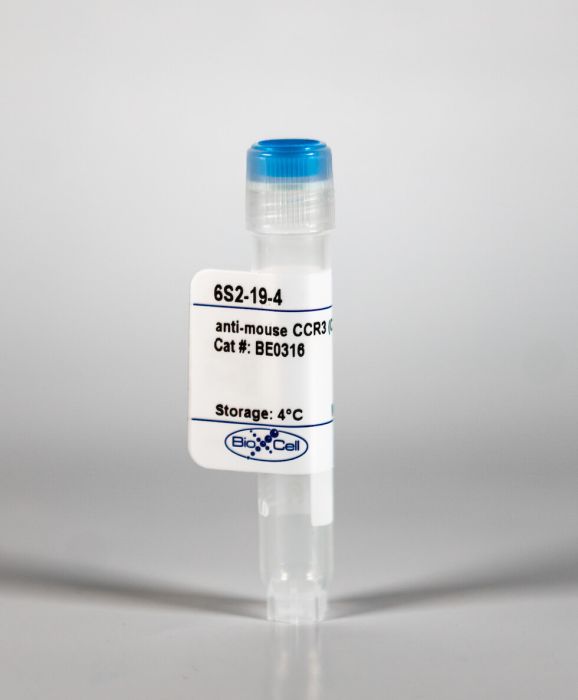InVivoMAb anti-mouse CCR3 (CD193)
Product Details
The 6S2-19-4 monoclonal antibody reacts with mouse CCR3 also known as CD193. CCR3 is a G protein-coupled, seven transmembrane, chemokine receptor expressed on a variety of hematopoietic cells including eosinophils, basophils, mast cells, mononuclear phagocytes, platelets, hematopoietic progenitor cells, and keratinocytes. CCR3 is most highly expressed on eosinophils. Chemokines including RANTES, eotaxin, eotaxin-3, MCP-3, and MIP1α have been reported to act as ligands for CCR3 and stimulate CCR3+ cells. CCR3 plays a role in atopic diseases such as dermatitis, allergic rhinitis, conjunctivitis and bronchial asthma. This receptor is thought to contribute to the accumulation and activation of eosinophils in the allergic airway and at sites of parasitic infection. It is also known to be an entry co-receptor for HIV-1. The 6S2-19-4 antibody has been shown to selectively deplete eosinophils when administered in vivo.Specifications
| Isotype | Rat IgG2b, λ |
|---|---|
| Recommended Isotype Control(s) | InVivoMAb rat IgG2b isotype control, anti-keyhole limpet hemocyanin |
| Recommended Dilution Buffer | InVivoPure pH 7.0 Dilution Buffer |
| Immunogen | Y3 cells expressing full length mouse CCR3 |
| Reported Applications | in vivo eosinophil depletion |
| Formulation |
PBS, pH 7.0 Contains no stabilizers or preservatives |
| Endotoxin |
<2EU/mg (<0.002EU/μg) Determined by LAL gel clotting assay |
| Sterility | 0.2 μM filtered |
| Production | Purified from tissue culture supernatant in an animal free facility |
| Purification | Protein G |
| RRID | AB_2754554 |
| Molecular Weight | 150 kDa |
| Storage | The antibody solution should be stored at the stock concentration at 4°C. Do not freeze. |
Recommended Products
in vivo eosinophil depletion
Depletion of eosinophils in mice through the use of antibodies specific for C-C chemokine receptor 3 (CCR3) PubMed
We have generated rat monoclonal antibodies specific for the mouse eotaxin receptor, C-C chemokine receptor 3 (CCR3). Several anti-CCR3 mAbs proved to be useful for in vivo depletion of CCR3-expressing cells and immunofluorescent staining. In vivo CCR3 mAbs of the IgG2b isotype substantially depleted blood eosinophil levels in Nippostrongyus brasiliensis-infected mice. Repeated anti-CCR3 mAb treatment in these mice significantly reduced tissue eosinophilia in the lung tissue and bronchoalveolar lavage fluid. Flow cytometry revealed that mCCR3 was expressed on eosinophils but not on stem cells, dendritic cells, or cells from the thymus, lymph node, or spleen of normal mice. Unlike human Th2 cells, mouse Th2 cells did not express detectable levels of CCR3 nor did they give a measurable response to eotaxin. None of the mAbs were antagonists or agonists of CCR3 calcium mobilization. To our knowledge, the antibodies described here are the first mAbs reported to be specific for mouse eosinophils and to be readily applicable for the detection, isolation, and in vivo depletion of eosinophils.
in vivo eosinophil depletion
Eotaxin-2 and IL-5 cooperate in the lung to regulate IL-13 production and airway eosinophilia and hyperreactivity PubMed
BACKGROUND: Eotaxin-2 is a member of the eotaxin subfamily of CC chemokines that display eosinophil-specific, chemotactic properties and has been associated with allergic disorders. However, the contribution of eotaxin-2 to the development of defined pathogenic features of allergic disease remains to be defined. OBJECTIVE: We sought to determine whether eotaxin-2 was a cofactor with IL-5 for the regulation of pulmonary eosinophilia and to identify the combined role of these molecules in the induction of phenotypic characteristics of allergic lung disease. METHODS: We instilled recombinant eotaxin-2 into the airways of wild-type mice that had been treated systemically with IL-5 or into IL-5-transgenic mice and characterized pulmonary eosinophil numbers, IL-13 production, and airway hyperreactivity (AHR) to methacholine. Mice deficient in the IL-4 receptor alpha-chain, IL-13, and signal transducers and activators of transcription 6 or mice treated with anti-CCR3 monoclonal antibody were also used. RESULTS: Eotaxin-2 and IL-5 cooperatively promoted eosinophil accumulation, IL-13 production, and AHR to methacholine. Neither eotaxin-2 nor IL-5 alone induced these features of allergic disease. IL-13 production was critically dependent on eotaxin-2- and IL-5-regulated eosinophilia, which predisposed to the development of AHR. AHR was dependent on IL-13 and signaling through the IL-4R alpha-chain and signal transducers and activators of transcription 6 pathways and the presence of eosinophils in the lung. CONCLUSION: These investigations demonstrate important cooperativity between eotaxin-2, IL-5, and IL-13 signaling systems and eosinophils for the development of hallmark features of allergic disease of the lung.
in vivo eosinophil depletion
Immunoglobulin E and eosinophil-dependent protective immunity to larval Onchocerca volvulus in mice immunized with irradiated larvae PubMed
Mice immunized with irradiated Onchocerca volvulus third-stage larvae developed protective immunity. Eosinophil levels were elevated in the parasite microenvironment at the time of larval killing, and measurements of total serum antibody levels revealed an increase in the immunoglobulin E (IgE) level in immunized mice. The goal of the present study was to identify the role of granulocytes and antibodies in the protective immune response to the larval stages of O. volvulus in mice immunized with irradiated larvae. Immunity did not develop in mice if granulocytes, including both neutrophils and eosinophils, were eliminated, nor did it develop if only eosinophils were eliminated. Moreover, larvae were killed in naive interleukin-5 transgenic mice, and the killing coincided with an increase in the number of eosinophils and the eosinophil peroxidase (EPO) level in the animals. To determine if EPO was required for protective immunity, mice that were genetically deficient in EPO were immunized, and there were no differences in the rates of parasite recovery in EPO-deficient mice and wild-type mice. Two mouse strains were used to study B-cell function; micro MT mice lacked all mature B cells, and Xid mice had deficiencies in the B-1 cell population. Immunity did not develop in the micro MT mice but did develop in the Xid mice. Finally, protective immunity was abolished in mice treated to eliminate IgE from the blood. We therefore concluded that IgE and eosinophils are required for adaptive protective immunity to larval O. volvulus in mice.
in vivo eosinophil depletion
Role of eosinophils and neutrophils in innate and adaptive protective immunity to larval Strongyloides in mice PubMed
The goal of this study was to determine the roles of eosinophils and neutrophils in innate and adaptive protective immunity to larval Strongyloides stercoralis in mice. The experimental approach used was to treat mice with an anti-CCR3 monoclonal antibody to eliminate eosinophils or to use CXCR2-/- mice, which have a severe neutrophil recruitment defect, and then determine the effect of the reduction or elimination of the particular cell type on larval killing. It was determined that eosinophils killed the S. stercoralis larvae in naive mice, whereas these cells were not required for the accelerated killing of larvae in immunized mice. Experiments using CXCR2-/- mice demonstrated that the reduction in recruitment of neutrophils resulted in significantly reduced innate and adaptive protective immunity. Protective antibody developed in the immunized CXCR2-/- mice, thereby demonstrating that neutrophils were not required for the induction of the adaptive protective immune response. Moreover, transfer of neutrophil-enriched cell populations recovered from either wild-type or CXCR2-/- mice into diffusion chambers containing larvae demonstrated that larval killing occurred with both cell populations when the diffusion chambers were implanted in immunized wild-type mice. Thus, the defect in the CXCR2-/- mice was a defect in the recruitment of the neutrophils and not a defect in the ability of these cells to kill larvae. This study therefore demonstrated that both eosinophils and neutrophils are required in the protective innate immune response, whereas only neutrophils are necessary for the protective adaptive immune response to larval S. stercoralis in mice.
in vivo eosinophil depletion
Major basic protein from eosinophils and myeloperoxidase from neutrophils are required for protective immunity to Strongyloides in mice PubMed
Eosinophils and neutrophils contribute to larval killing during the primary immune response, and neutrophils are effector cells in the secondary response to Strongyloides stercoralis in mice. The objective of this study was to determine the molecular mechanisms used by eosinophils and neutrophils to control infections with S. stercoralis. Using mice deficient in the eosinophil granule products major basic protein (MBP) and eosinophil peroxidase (EPO), it was determined that eosinophils kill the larvae through an MBP-dependent mechanism in the primary immune response if other effector cells are absent. Infecting PHIL mice, which are eosinophil deficient, with S. stercoralis resulted in development of primary and secondary immune responses that were similar to those of wild-type mice, suggesting that eosinophils are not an absolute requirement for larval killing or development of secondary immunity. Treating PHIL mice with a neutrophil-depleting antibody resulted in a significant impairment in larval killing. Naive and immunized mice with neutrophils deficient in myeloperoxidase (MPO) infected with S. stercoralis had significantly decreased larval killing. It was concluded that there is redundancy in the primary immune response, with eosinophils killing the larvae through an MBP-dependent mechanism and neutrophils killing the worms through an MPO-dependent mechanism. Eosinophils are not required for the development or function of secondary immunity, but MPO from neutrophils is required for protective secondary immunity.
in vivo eosinophil depletion
CCR3 Blockade Attenuates Eosinophilic Ileitis and Associated Remodeling PubMed
Intestinal remodeling and stricture formation is a complication of inflammatory bowel disease (IBD) that often requires surgical intervention. Although eosinophils are associated with mucosal remodeling in other organs and are increased in IBD tissues, their role in IBD-associated remodeling is unclear. Histological and molecular features of ileitis and remodeling were assessed using immunohistochemical, histomorphometric, flow cytometric, and molecular analysis (real-time RT-PCR) techniques in a murine model of chronic eosinophilic ileitis. Collagen protein was assessed by Sircol assay. Using a spontaneous eosinophilic Crohn’s-like mouse model SAMP1/SkuSlc, we demonstrate an association between ileitis progression and remodeling over the course of 40 weeks. Mucosal and submucosal eosinophilia increased over the time course and correlated with increased histological inflammatory indices. Ileitis and remodeling increased over the 40 weeks, as did expression of fibronectin. CCR3-specific antibody-mediated reduction of eosinophils resulted in significant decrease in goblet cell hyperplasia, muscularis propria hypertrophy, villus blunting, and expression of inflammatory and remodeling genes, including fibronectin. Cellularity of local mesenteric lymph nodes, including T- and B-lymphocytes, was also significantly reduced. Thus, eosinophils participate in intestinal remodeling, supporting eosinophils as a novel therapeutic target.


